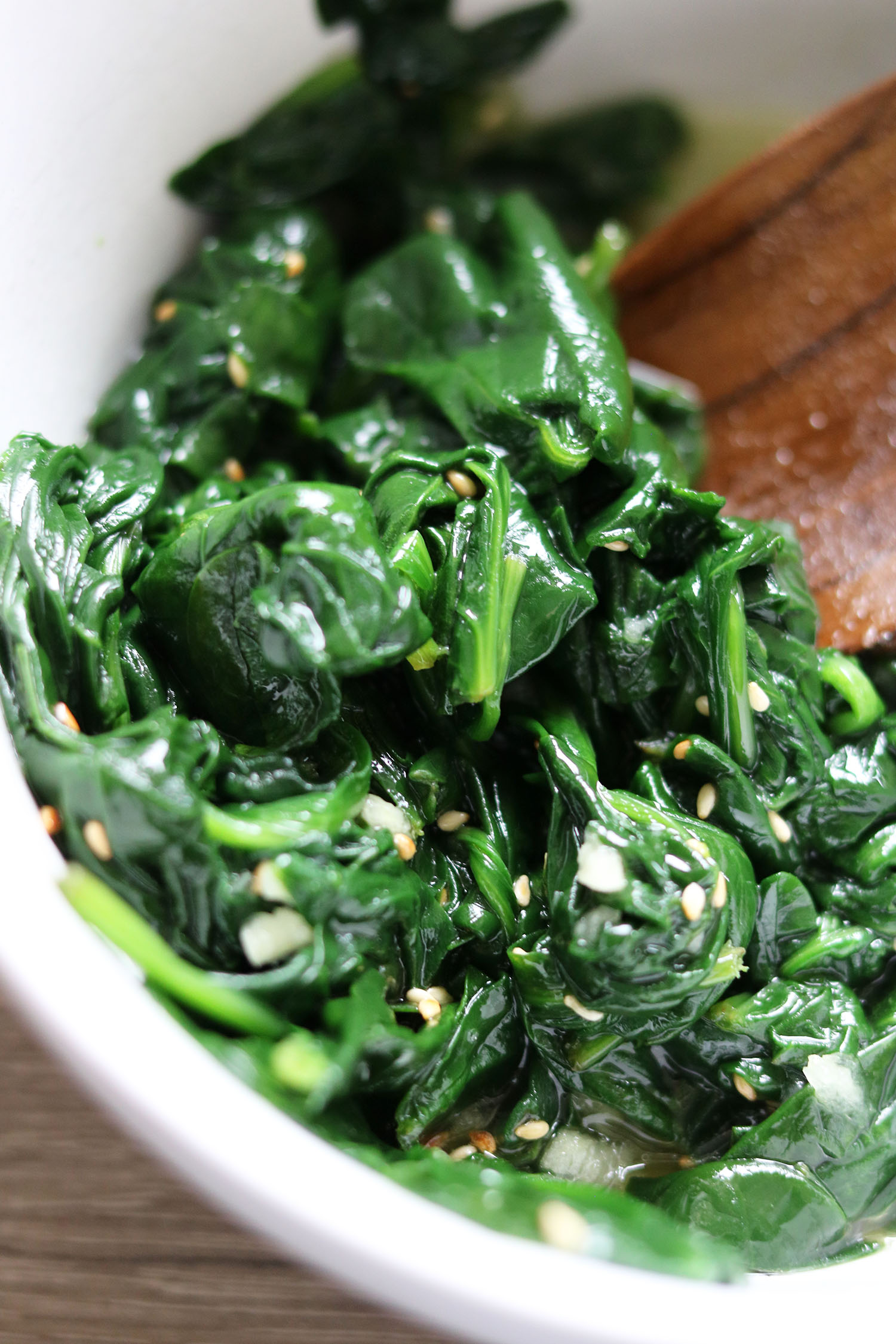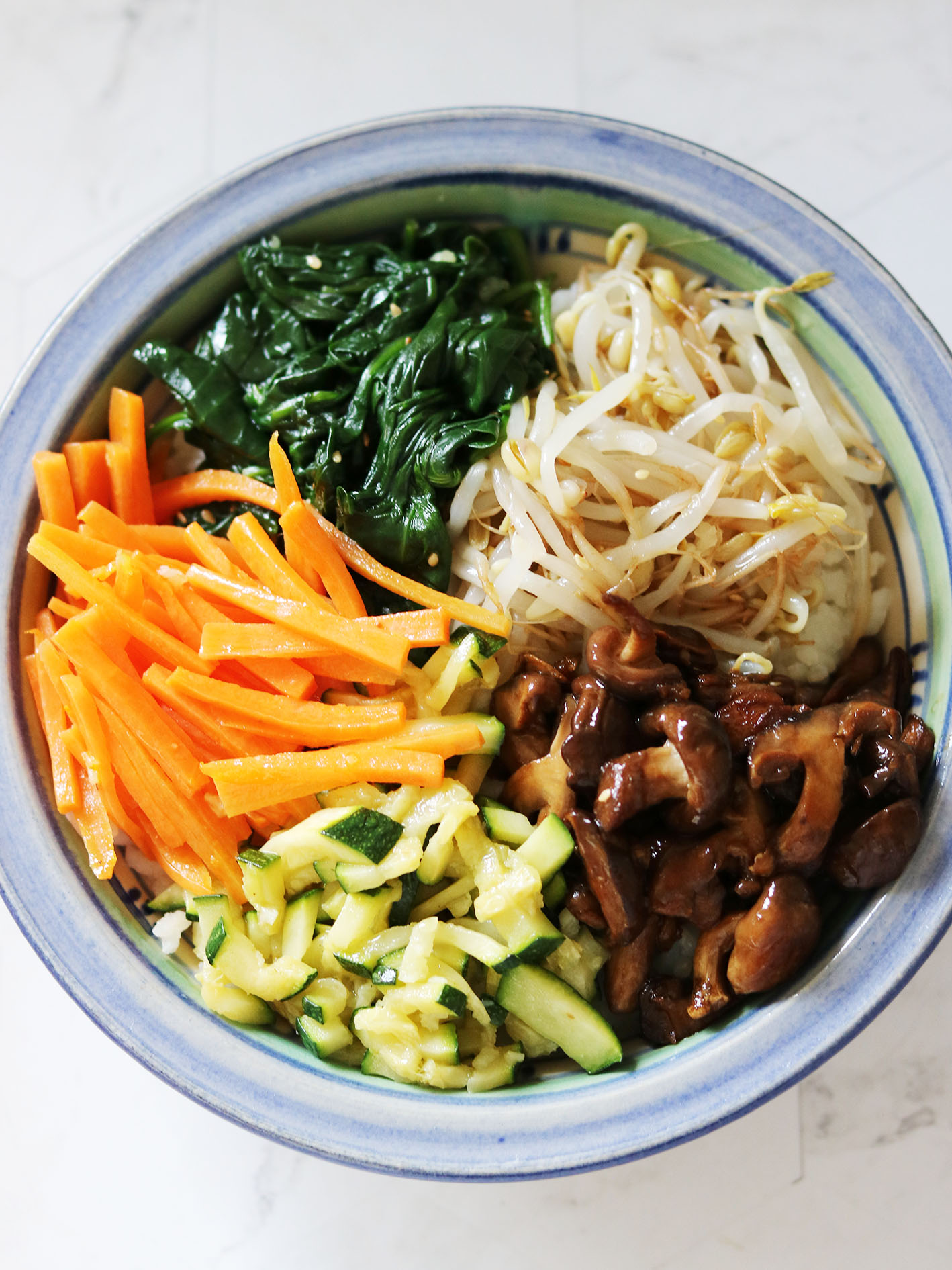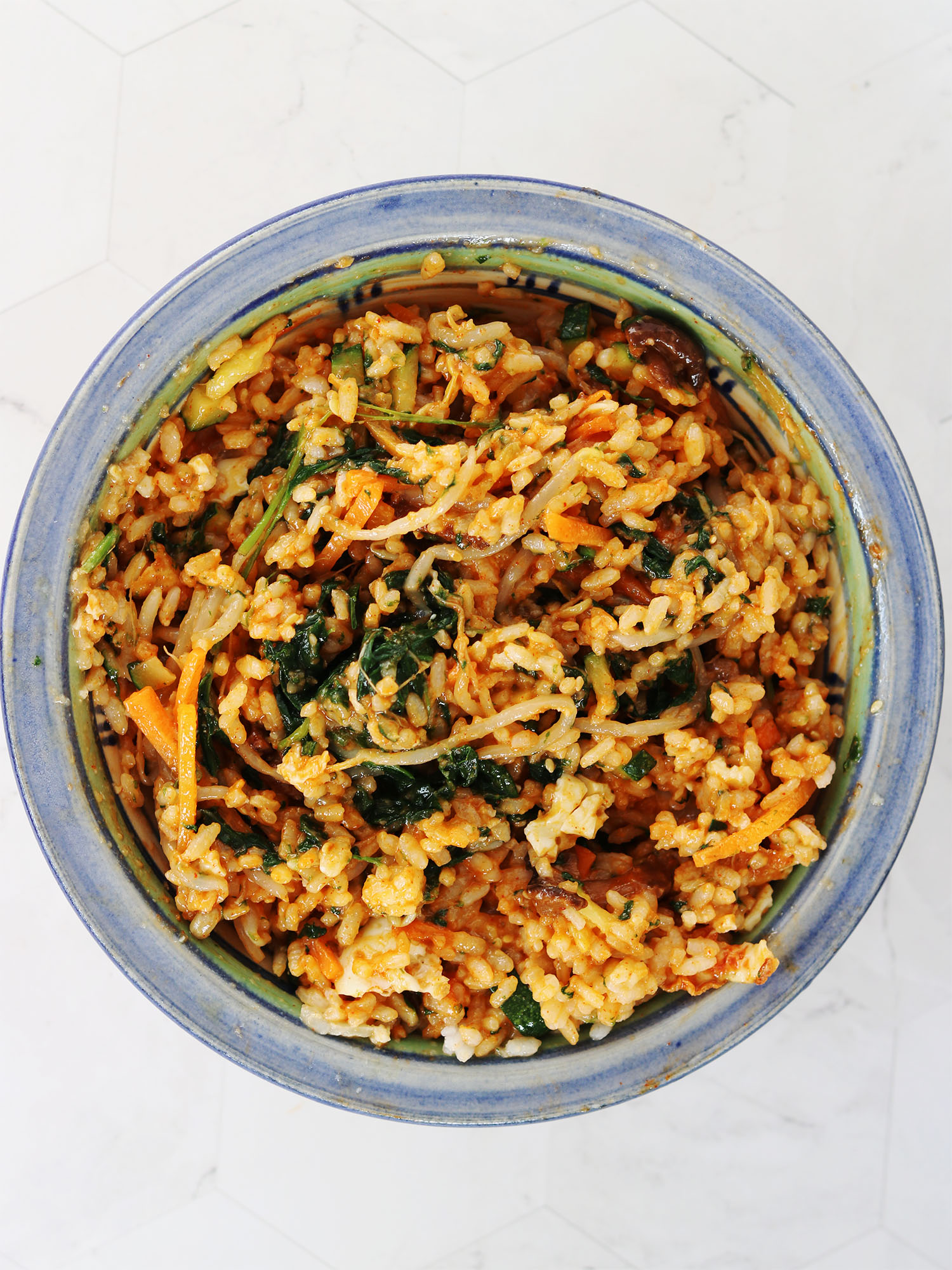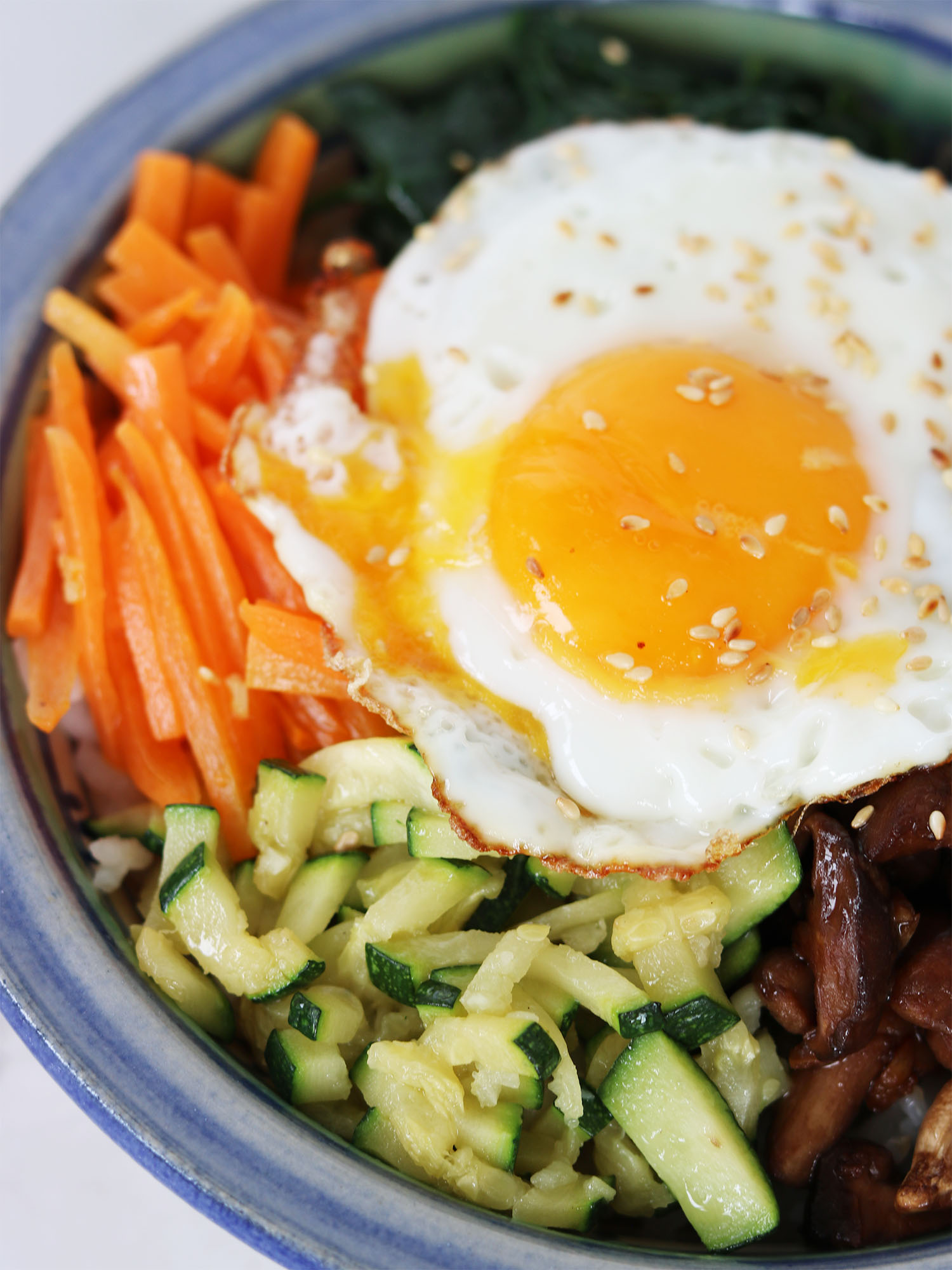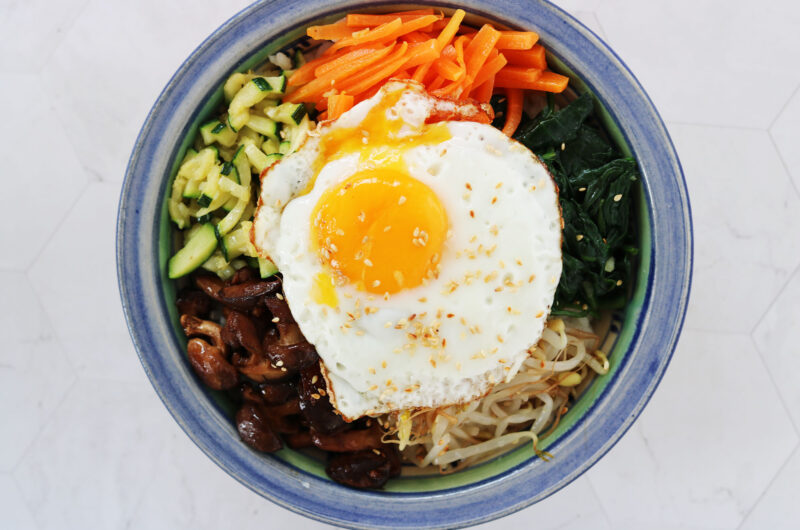
Bibimbap is a true Korean classic, and one of those dishes that I never get tired of and I’m not kidding when I’m telling you that I could eat bibimbap every day, for breakfast, lunch and dinner:) Directly translated, bibimbap means “mixed rice,” which captures the concept very well, as bibimbap is rice served with various types of colorful vegetable toppings, neatly arranged in separate segments. Contrary to what many believe, raw vegetables are not used in bibimbap. All the vegetables are either blanched or sautéed and seasoned with a bit of sesame oil, salt, and garlic.
The ingredients are prepared separately, so making your own bibimbap might seem a bit daunting, not to mention very time-consuming. However, with a bit of planning and proper preparation, it’s a rather smooth process, and I promise you it will be worth the effort, because homemade bibimbap is truly delicious.
Considering how much work that goes into arranging the toppings in small, well-defined segments, I almost feel bad about telling you, that before you start eating, you mix it all together, destroying the nice styling. Though it is really important that you mix everything well, before you start eating, so each mouthful contains a little bit of everything.
Bibimbap can be served in a regular bowl at room temperature or as dolsot bibimbap in a hot stone bowl that makes the rice crispy and keeps the dish warm throughout the meal. When served as dolsot bibimbap, the dish is often accompanied by raw beef as a topping and a raw egg yolk instead of a fried egg, as the heat from the stone bowl cooks the egg when mixed. When I’m dining out, I would usually order dolsot bibimbap, but since most of us don’t have a dolsot bowl at hand, this recipe is just for regular bibimbap.
Shop JookJangYeon gourmet gochujang:
Notes
Rice: Use short grain, white rice for the best result. If you don’t have an asian specialty store nearby, you can use sushi rice, available in most grocery stores.
Spinach: You can use baby spinach or regular spinach. If using regular spinach, be sure to remove the coarse stems, and cut the spinach a few times after blanching.
Bean Sprouts: Mung bean sprouts are typically used for bibimbap. They are usually available in most grocery stores.
Mushrooms: I use shiitake mushrooms in this recipe, as they have a very meaty, rich flavor, but you can use any type of mushroom you like. If you’re not a fan of mushrooms, you could add some tofu cubes instead to make the dish more filling.
Gochujang is a Korean fermented paste made from chili, rice, soybeans, and salt. Gochujang is typically served in a small bowl on the side, so you can decide yourself how spicy your bibimbap should be. Gochujang is rather spicy, so if you haven’t tasted it before, or aren’t good with spicy food, start with half a teaspoon. You can always add more later.
Sesame Oil: Sesame oil is not used for frying, but as a seasoning. Good sesame oil is quite expensive, but you only use a little, and it makes a huge difference in taste. The sesame oil should be golden brown in color and is often sold in small bottles. If the oil is in a large white plastic container, it’s probably sesame oil for frying, which is a different thing. Ask at your local Asian supermarket, they will know what you’re after.
Here is a brief overview of what needs to be done, and when the different tasks should be performed:
Start by preparing all the ingredients. Cut the vegetables and mushrooms, get the salt and sesame oil ready, toast the sesame seeds, and press the garlic.
Then cook the rice and while the rice is cooking (and resting), cook the vegetables, mushrooms, and eggs.
Hopefully, everything will be ready around the same time, so you can assemble and serve your bibimbap while the rice is still warm.
Recipe: Bibimbap with vegetables, mushrooms and fried egg
2
servingsBibimbap is a true Korean classic, and one of those dishes that I never get tired of. I could eat bibimbap every day for breakfast, lunch and dinner:) Directly translated, bibimbap means “mixed rice,” which captures the concept very well, as bibimbap is rice served with various types of vegetable toppings, arranged in separate segments. Contrary to what many believe, raw vegetables are not used in bibimbap. All the vegetables are either blanched or sautéed and seasoned with a bit of sesame oil, salt, and garlic.
Keep the screen of your device on
Ingredients
Rice for 2 persons (around 2 cups cooked rice)
- TOPPINGS
1 cup mung bean sprouts
4 cups fresh spinach leaves
1 carrot (~ 1 cup, julienned or cut into matchsticks)
½ zucchini (~ 1 cup, julienned or cut into matchsticks)
8-10 shiitake mushrooms ( ~ 1 cup, cut)
2 eggs
1-2 tablespoons Vegetable oil for frying
- SEASONING FOR THE VEGETABLES
Salt
2 tablespoons sesame seeds
Sesame oil (~ ½ cup)
5 cloves garlic
1 dash soy sauce
- Sauce
Gochujang
Directions
- PREPARATION
- Prepare the vegetables and mushrooms so they are measured, cut, and lined up, ready to use:
Carrots: Cut or julienne the carrots into matchsticks.
Zucchini: Cut or julienne the zucchini into matchsticks.
Mushrooms: Cut the mushrooms into quarters.
Bean Sprouts: You need ~ 1 cup.
Spinach: You need ~ 4cups. - RICE
- Cook the rice according to instructions on the packaging. It’s better to undercook the rice slightly than to overcook and risk that it turns all mushy and soggy.
- VEGETABLES, MUSHROOMS, AND EGGS
- Get sesame oil and salt ready. Mince the garlic. Toast the sesame seeds in a dry pan until golden. Bring out the soy sauce (to be used with the mushrooms).
- Blanch the beansprouts
Blanch the bean sprouts. The easiest way to do this is to fill a large pot with water and bring it to a boil. Place the bean sprouts in a large stainless steel strainer.
Lower the strainer into the water and blanch for 1-2 minutes.
Transfer the bean sprouts to a bowl and set aside for later. - Blanch the spinach
Blanch the spinach You can use the pot with water from the bean sprouts.
Place the spinach in a large stainless steel strainer. You may need to blanch in two batches if all the spinach doesn’t fit in the strainer.
Lower the strainer into the water and blanch for ½ -1 minute.
Transfer the spinach to another bowl and set aside for later. - Seasoning for spinach and bean sprouts
Spinach: Mix in ½ teaspoon minced garlic, 1 teaspoon sesame oil, a pinch of salt, ½ teaspoon toasted sesame seeds.
Beansprouts: Mix in ½ teaspoon minced garlic, 1 teaspoon sesame oil, a pinch of salt, ½ teaspoon toasted sesame seeds. - Carrots and zucchini: Sauté for 1-2 minutes. The vegetables should still be al dente. Season with salt, garlic and sesame oil.
- Mushrooms: Sauté the mushrooms in the pan with a little cooking oil. Add a little soy sauce and season with sesame oil and garlic (no salt needed).
- Eggs: Fry the eggs sunny side up.
- ASSEMBLE THE BIBIMBAP
- Scoop the cooked rice into two bowls. Arrange the 5 different toppings in separate sections over the rice.
- Place a fried egg on top of each bowl. Drizzle with toasted sesame seeds. Serve with gochujang on the side.
